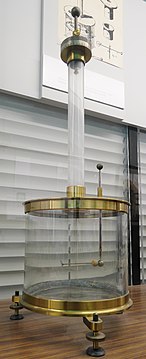Rotary balance
A torsion balance ( also: torsion balance ) has been used since the 19th century to measure very small forces, e.g. B. the mass attraction ( gravitation ) between two lead balls or the electrostatic attraction between two differently charged bodies.
A similar instrument was developed around 1910 by the Hungarian geophysicist Loránd Eötvös for measuring gravity gradients . It served u. a. the exploration of underground raw materials and geoid determination .
Working principle
The functional principle of the first type of instrument is: A large, stationary mass (lead ball) gravitationally attracts a smaller ball. To do this, a rod is suspended in the middle of a torsion wire and a small ball of earth is attached to each end. Two large mass balls are fixed at a suitable distance and symmetrically to the rotatably suspended balls. The mutual attraction then causes a deflection or rotation of the rod, which is opposed by the torsional moment of the wire. The gravitational constant can be calculated from the angle of rotation.
Usually the force acting is so small that the change in position of the ball by deflecting a light beam by a mirror ( light pointer ) attached to the hanging thread has to be enlarged sufficiently to be able to be precisely determined. In order not to influence the measurement by air resistance, the balance is in an evacuated container.
With the rotary balance, the gravitational constant, which is very important for physics and technology (e.g. in space travel) , became for the first time
certainly.
Historical dates
The principle of the rotary balance or gravitational balance was first worked out and used by the following scientists:
- About 1760 John Michell described the principle of the rotary balance and built a device, but then took care of other areas of science.
- In 1784 Charles-Augustin de Coulomb described the use of a rotating balance to investigate the repulsive and attractive forces of electrical charges.
Replica of the original Coulomb rotary balance in the Deutsches Museum in Munich
- Around 1797, Michell's apparatus came into the hands of Henry Cavendish via Francis John Hyde Wollaston , who used it to measure the forces of attraction of masses and thus determine the gravitational constant . In his report to the Royal Society of his experiments, Cavendish made explicit reference to Michell's merits.
- In 1906, the geophysicist Loránd Eötvös built a modification of the rotary balance and in turn determined the gravitational constant. Therefore, he is also often seen as the "inventor" of the rotary balance.
- Around 1920 Eötvös developed a rotary scale suitable for measuring gravity gradients . With it, the geophysical exploration of crude oil deposits and in the Hungarian lowlands also the measurement of vertical deviations begins .


